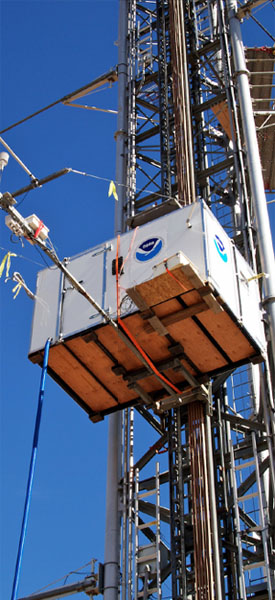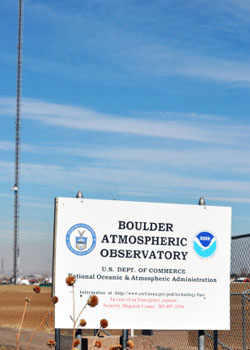Taking science to new heights
Erie Tall Tower study gives fresh insights on wintertime air pollution


A sophisticated chemistry laboratory, packed into a room-sized container, travels up and down the Boulder Atmospheric Observatory (BAO) in Erie, Colo., to sample the atmosphere from the ground up to nearly 1,000 feet.
By Jane Palmer
Teetering atop a 1,000-foot, needle-shaped tower in Erie, Colo., might seem like an extreme approach to exploring air pollution, but CIRES scientist Carsten Warneke says this novel approach is ideal.
“It is like a pollution crossroads,” Warneke said, speaking of Erie. The tower sits downwind of Denver, very close to natural gas production sites and gets the not-so-subtle smells and gases from Greeley, Colo., dairy farms. The three sources combine to give the researchers plenty to investigate, and the location also occasionally gets a break in the form of clean air funneling in from the Rockies. “Basically it provides a baseline,” Warneke said. “It is as clean as you can get.”
The tower itself also gives the researchers a unique perspective on air pollution. What’s in the air and the chemical interactions that take place in it vary with height, and therefore cannot be fully understood by making measurements only at ground level, Warneke said.
In March and February 2011, CIRES and NOAA scientists conducted a study on the chemistry of wintertime nighttime atmosphere at the tower—dubbed the Nitrogen, Aerosol Composition, and Halogens on a Tall Tower (NACHTT) study. The experiment was one of the first of its kind: “Nighttime and winter air pollution have been studied very little,” Warneke said.
The wintertime atmosphere is made up of “layers” that don’t mix well, Warneke said. During the NACHTT study, a mobile “Tower Laboratory” platform carried more than one ton of instrumentation up and down the 1,000-foot tower, characterizing the
The Science
The 1,000-foot-tall tower in Erie, Colo., allows scientists to investigate the air—and the reactions that take place in it—at a variety of heights.
chemistry at different heights. “Going through those layers tells you more about the chemistry and air pollution,” he said.
Observing the atmosphere at nighttime also allowed the researchers to understand how a compound called nitryl chloride is made—a chemical that contributes indirectly to smog formation and also influences the chemical cycles that destroy or produce various greenhouse gases. During the night, chloride compounds in the atmosphere interact with nitrogen oxide pollution, produced by fossil fuel combustion, to form nitryl chloride. But exactly where the atmospheric chloride comes from in a region so far from the oceans, and how the nighttime chemistry unfolds to produce nitryl chloride, are not fully understood.
The NACHTT study is sure to advance the understanding of what goes on in the air in the dead of winter, and at night, Warneke said, and the bird’s-eye view of the Erie Tower makes the experiment possible.
Early in the morning, from the top of the tower, the researchers can see the “mixing layer” where a lot of the pollution is trapped, Warneke said. “This is the layer that most of us live in,” he said. “And that is why it is so important to understand its emissions, chemistry and dynamics.”


